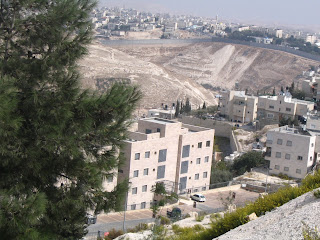I saw an ad in Hebrew during the holidays in the Jerusalem Post from Ir Amim , promoting their study tours of East Jerusalem. First I wrote to them asking why they put a Hebrew ad in an English newspaper, when the Post readers obviously don't want to deal with reading Hebrew in any way/shape/form - and then I signed up for their free study tour about three weeks ago one Friday morning.
The tour lasted about four hours, taking us to the southernmost part of Gilo, overlooking Beit Jalah, El Khader and Bethlehem, then driving past Har Homa through Sur Baher and Jabel Mukaber...
A tree grows in Sur Baher
We saw the new Jewish housing built right at the edge of Jabel Mukaber. The ads for this project, Nof Zion, say nothing of it being right at the edge of this town! But it is touted as luxurious living.
The spiffy Jewish neighborhood of Nof Zion at the edge of Jabel Mukaber.
Then on to the wall which divides the neighborhood of Abu Dis - cutting right through it.
Then to French Hill/Issawiya overlooking the disputed E1 area.
Some of the things I found out from Ir Amim were:
1. There are 10,000 Arab children not registered in schools (due to lack of space). There is a lack of 1,500 classrooms that the Jerusalem municipality failed to provide. Therefore, many classes take place in private homes/apartments and often Hamas and the Islamic Trust provide schooling, being that the Jerusalem municipality doesn't. Support for these extremist groups is growing in these East Jerusalem neighborhoods, as a result.
2. Neighborhoods in East Jerusalem do not have zoning plans, so most homes are illegal and prone for demolition (as high as over 90%!). When families expand, what can they do? Where can they go? So they: a) build illegally; b) live in one house all together, causing overcrowding.
3. East Jerusalem Arabs DO pay their municipal taxes (many Israelis believe they don't). This is a way to prove Jerusalem residency. If they do not pay taxes, or leave Jerusalem, after seven years they may lose their residency rights.
4. There is a lack of playgrounds and parks throughout East Jerusalem. In fact, I hadn't seen one playground or park the entire trip, unlike West Jerusalem, where they are in abundance. Garbage collection is not supplied by the Jerusalem municipality.
5. Black water tanks on rooftops were pointed out to us. People get their water supply independently. The Jerusalem municipality doesn't supply water for them, so they have to bring it in privately. Garbage collection is also not supplied by the municipality.
6. Seeing the wall that divides Abu Dis from Jerusalem mid-neighborhood, we were asked if the people that live behind the wall are any more dangerous than the people living in front of the wall. Being that the last two Jerusalem terrorists lived in front of the wall and not behind it, does it mean the people are even more dangerous behind this wall? Many people, because of lack of housing in Jerusalem, went to live in nearby Abu Dis. They have Jerusalem area residency cards, but have now found themselves behind the wall.
I was happy to see a more recent email with a link to a Haaretz article that 160,000 people living in East Jerusalem will finally be connected to water through the municipality. That's a happy first. Perhaps they'll consider that it's also a good idea to help the children of East Jerusalem get an education. Because if they don't do it, someone else will.
Thursday, November 13, 2008
Study Tour of Jerusalem by Ir Amim
Subscribe to:
Post Comments (Atom)



1 comment:
Wow, thank you so much for posting this! It is really interesting to get real, unbiased information from "the other side" - as many people perceive the arabs in Israel, especially in Jerusalem. I'm seriously considering making aliyah next year, and being more aware about these situations is truly important, and particularly in my case, since I'd be living in Jerusalem during the first months.
Post a Comment